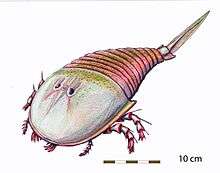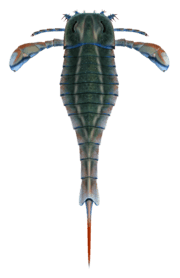Campylocephalus
| Campylocephalus | |
|---|---|
 | |
| Carapace of C. oculatus | |
| Scientific classification | |
| Kingdom: | Animalia |
| Phylum: | Arthropoda |
| Subphylum: | Chelicerata |
| Order: | †Eurypterida |
| Superfamily: | †Mycteropoidea |
| Family: | †Hibbertopteridae |
| Genus: | †Campylocephalus Eichwald, 1860 |
| Type species | |
| †Campylocephalus oculatus Kutorga, 1838 | |
| Species | |
| |
| Synonyms | |
| |
Campylocephalus is a genus of eurypterid, an extinct group of aquatic arthropods. The genus contains three species; C. oculatus and C. permianus from the Permian of Russia and C. salmi from the Carboniferous of the Czech Republic.[1] The generic name is composed of the Greek words καμπυλος (kampýlos), meaning "curve", and κεφάλι (kefáli), meaning "head".[2]
The large species C. permianus, known from deposits of Late Permian age in Russia, was the last known surviving eurypterid.[3]
Description

In overall appearance, Campylocephalus was similar to other hibbertopterid eurypterids. This group were large, broad and heavy creatures quite unlike the famous swimming eurypterids, such as Pterygotus and Eurypterus. Campylocephalus can be distinguished from other eurypterids of its family by the subelliptical prosoma (head), which is subsemicircular, strongly convex and at its broadest in the midsection. Its compound eyes were laterally placed, and separated by inflated lobes. The eyes also possessed palpebral lobes, placed on the posterior half of the carapace (the exoskeleton segment covering the head). The tergites of the abdomen were convex in shape, and possessed articular processes. The appendages are rarely preserved in Campylocephalus fossils and are as such almost completely unknown.[4][5]
The incomplete nature of fossil remains referred to Campylocephalus makes determining its size difficult, with no size estimates existing for either the type species or C. salmi. The massive incomplete carapace referred to C. permianus suggests a large eurypterid, potentially reaching lengths of 1.4 metres (4.6 feet).[6]
History of research

Campylocephalus fossils were first described as belonging to a species of the genus Limulus, the same genus as the modern atlantic horseshoe crab, as Limulus oculatus by Stepan S. Kutorga, citing similarities with members of the modern genus in the appearance and anatomy of the somewhat incomplete fossil.[7] In 1860, Edouard D'Eichwald recognized that the carapace and the thoracic segments of the species were distinct from Limulus and promoted it to the genus level. As in other species, the carapace was very convex with small irregular prominences, with a rounded anterior edge and an indented posterior edge. The compound eyes were semilunar and placed near the middle of the carapace, with ocelli (light-sensitive simple eyes) between them. The thoracic segments were straight and narrow.[2]
The second species of Campylocephalus, C. salmi, was originally described as a species of Eurypterus in 1877 by Dionýs Štúr. He based its description in two carapaces. The first one only preserves the lower part. This fragment ends in two pointed concave arches. The eyes are in the middle very close to each other, with a triangular elevation below that also appears in Hibbertopterus scouleri. In the second, above the eyes, the carapace begins to stretch forward. Both fossils have protuberances of different sizes that show very vague forms.[8]
The species of C. permianus represents the latest known surviving eurypterid species.[3] Originally described by Alexey G. Ponomarenko in 1985 as a species of the related Hibbertopterus based on the holotype PIN N1209/2 (consisting of an incomplete carapace), Ponomarenko listed several features that distinguished the species from other species of Hibbertopterus. These include features such as the posterior position of the lateral eyes and that these eyes were not circular in shape. In 2012, James C. Lamsdell demonstrated that these supposedly unique features were actually diagnostic of Campylocephalus, and referred the species to the genus as C. permianus.[5]
Lamsdell diagnosed C. permianus as a species of Campylocephalus with the "lateral eyes markedly converging posteriorly" and noted that the features that Ponomarenko had used to distinguish the species from Campylocephalus, that C. permianus possessed a different carapace shape and cuticular thickening around the eyes, were invalid as C. oculatus (the type species) is not well preserved enough to determine the structure of the eyes and that its carapace is both flattened and incomplete, meaning that the shape can not be accurately determined.[5]
See also
References
- ↑ Dunlop, J. A., Penney, D. & Jekel, D. 2015. A summary list of fossil spiders and their relatives. In World Spider Catalog. Natural History Museum Bern, online at http://wsc.nmbe.ch, version 16.0 http://www.wsc.nmbe.ch/resources/fossils/Fossils16.0.pdf (PDF).
- 1 2 D'Eichwald, Edouard (1860). "2". Lethaea rossica ou Paléontologie de la Russie. 1. p. 1360.
- 1 2 Tetlie OE (2007). "Distribution and dispersal history of Eurypterida (Chelicerata)" (PDF). Palaeogeography, Palaeoclimatology, Palaeoecology. 252 (3–4): 557–574. doi:10.1016/j.palaeo.2007.05.011. Archived from the original (PDF) on 2011-07-18.
- ↑ Størmer, L 1955. Merostomata. Treatise on Invertebrate Paleontology, Part P Arthropoda 2, Chelicerata, P39.
- 1 2 3 Lamsdell, James (2012-03-01). "Redescription of Drepanopterus pentlandicus Laurie, 1892, the earliest known mycteropoid (Chelicerata: Eurypterida) from the early Silurian (Llandovery) of the Pentland Hills, Scotland". Earth and Environmental Science Transactions of the Royal Society of Edinburgh. 103. doi:10.1017/S1755691012000072.
- ↑ Lamsdell, James C.; Braddy, Simon J. (2009-10-14). "Cope's Rule and Romer's theory: patterns of diversity and gigantism in eurypterids and Palaeozoic vertebrates". Biology Letters: rsbl20090700. doi:10.1098/rsbl.2009.0700. ISSN 1744-9561. PMID 19828493. Supplementary information
- ↑ Kutorga, S. (Stepan) (1838). Beitrag zur Kenntniss der organischen Ueberreste des Kupfersandsteins am westlichen Abhange des Urals. Museum Victoria. Mineralogischen Gesellschaft.
- ↑ Štúr, Dionýs (1877). Die Culmflora der Ostrauer und Waldenburger Schichten. 8. Hölder. pp. 449–450.
